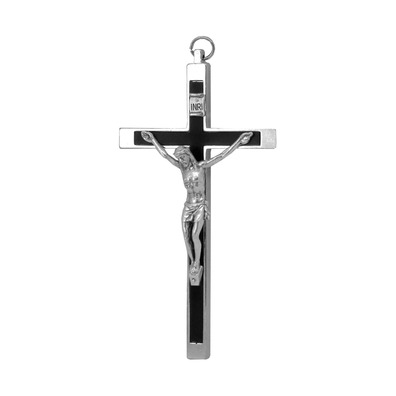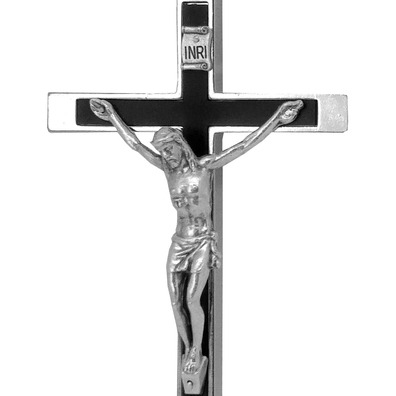14,5 cm. Cursillo Cross | Cross for Cursillos Christianity Movement
8,00€
Taxes includedCatholic product in stock. Products ready to be shipped. You can check the approximate delivery time during the purchase process.
Cursillo Cross | Cross for Cursillos Christianity Movement
- Cursillo Cross, a representative symbol of the Cursillo Christianity Movement.
- Made of silver-plated metal with black enameled details.
- Dimensions of the Cross:
- 14.5 cm (5.71 in) high.
- 7.5 cm (2.95 in) wide.
- Dimensions of the Christ figure:
- 7.0 cm (2.76 in) high.
- 5.0 cm (1.97 in) wide.
- Includes the inscription "INRI" at the top.
- Designed for hanging, perfect for retreats, meetings, and spiritual activities.
Cursillo Christianity Movement
The Cursillo Christianity Movement, popularly known as Christianity Movement, is an ecclesial movement recognized within the Catholic Church. It originated between 1940 and 1949 at the Monastery of San Honorato in Randa, Mallorca.
The founders of the Cursillo Christianity Movement were a group of laypeople and priests from the Diocesan Council of Young People of Catholic Action (JAC) in Mallorca. They organized a series of retreats to prepare parishioners for the national pilgrimage to Santiago de Compostela in 1948. Notable figures among the founders include Eduardo Bonnín Aguiló, Mons. Sebastián Gayá Aguilera, D. Juan Capó Bosch, and the Bishop of Mallorca, Mons. Juan Hervás Benet.
These retreats, known as the Cursillos for Advanced Pilgrims and the Cursillos for Pilgrim Leaders, were the seeds that grew into what we now know as the Cursillo Christianity Movement.
The first Cursillo Movement was held in January 1949 at the Monastery of San Honorato in Mallorca. That same year, 20 retreats were conducted.
Quickly recognizing the evangelizing potential of the initiative, organizers decided to formally structure the Movement of Cursillos de Cristiandad (MCC). They established the School of Leaders, the Diocesan Secretariat, and defined post-Cursillo gatherings known as "Ultreyas."
The MCC expanded from Mallorca to mainland Spain in 1953, starting in Valencia. Thanks to local initiatives and a pastoral letter in 1957, the movement spread rapidly across Spain, preparing for international growth.
In 1953, the movement also began its journey in the Americas. The first Cursillo Christianity Movement outside Spain was held in Colombia.
In Europe, the MCC faced the challenge of language but managed to establish itself in Portugal, Austria, and Italy by 1960, and in Germany by 1961. By 1974, the movement reached Eastern Europe from Austria, marking a significant milestone in its expansion.
In Asia, the MCC began in the Philippines in 1962. In Australia, it was established in 1963 among Spanish immigrants and expanded to the local population by 1965. From the Philippines, the MCC extended to other Asian countries, also reaching parts of Africa.
The Stages of Cursillo Christianity Movement
A Cursillo Christianity Movementis divided into three main stages:
- Pre-Cursillo: Preparation and selection of candidates to ensure they are ready for the experience.
- Cursillo: A three-day retreat that includes talks, prayers, and community activities.
- Post-Cursillo: Participation in gatherings called "Ultreyas," which strengthen community and spirituality.
The Meaning of the Cross in gatherings and ultreyas
The Cross holds an essential place in the Cursillo Christianity Movement. It symbolizes Christ's sacrifice and infinite love for humanity, serving as inspiration and strength for participants' faith.
The Cross symbolizes redemption and eternal life, transcending suffering and death. It is a point of support for seeking a new life and spiritual transformation through prayer, reflection, and rituals.
Additionally, the Cross is a powerful evangelization tool, inspiring Cursillistas to live and share their faith with the community they belong to.
Ultreya, keep going
The word "Ultreya" originates from a greeting used by pilgrims on the Camino de Santiago to encourage and support each other on their journey.
This expression, filled with energy and hope, derives from the Latin "ultra," meaning "keep going!" It evokes a sense of perseverance and continuity on the path to one’s goal. Additionally, "Ultreya" reflects a sense of belonging, union among pilgrims, and community.
These values inspired the selection of the term "Ultreya" for periodic post-Cursillo gatherings.
Post-Cursillo gatherings are moments of unity where participants share their faith, experiences after attending the Cursillo, and the fruits they have harvested throughout their spiritual journey.
These meetings can occur at diocesan, national, or even international levels, fostering connections between different communities and strengthening bonds among Cursillista participants.






